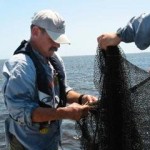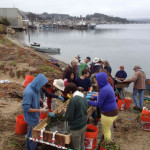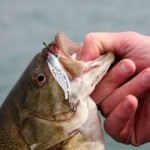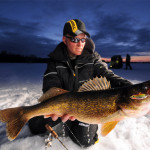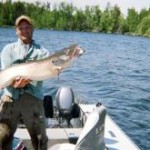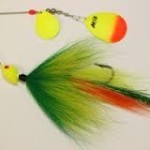If your idea of ideal summer bass fishing is rocking and rolling in the wakes of off shore yachts and ski boats while listening to the incessant buzz of mosquito like jet skis, Lake Russell is not for you. At Russell you are likely to see more bass boats than jet skis and fishermen usually outnumber water skiers on a summer day.
Lake Russell is located between the Lake Hartwell dam and the upper end of Clark’s Hill on the Savannah River. It reached full pool in 1984 and its 26,650 acres of water cover parts of Georgia and South Carolina. You can fish the whole lake with a license from either state and there is a ten bass daily limit.
When the Corps of Engineers built lake Russell much of the timber was left standing. There are many coves and creeks where the timber sticks out of the water and more areas where it is below the surface. The channel is marked by telephone poles set on the ends of points and these poles show the extent of the shallow water near the channels.
One of the most outstanding characteristics of Lake Russell is its natural shoreline. Development is restricted so there are no houses or docks on the lake. There are two state parks with camping, several boat ramps and a marina, but most of the shoreline is still in its natural wooded state. This is pretty, but it also means access is limited and fewer boats are on the water.
Since Russell is a Corps of Engineers lake, biologists from the state and the Corps work together to monitor fish populations and habitat. Bubba Mauldin is the Georgia fisheries biologist responsible for the lake, and he says bass are healthy and the habitat seems to be improving.
Russell is a pumpback lake and there was some early problems with oxygen levels, but an aerating system to inject oxygen into the water near the dam helps both Clarks Hill and Russell. This year the turbines at Hartwell are being renovated and will have a venting system to put some air into the water as they operate, giving even more oxygen content to the waters of Lake Russell.
In the early years Russell was a largemouth lake since spotted bass are not native to the Savannah River system. Fishermen took it on themselves to start a “midnight socking” program and now spots make up about half the population in numbers of bass in the lake. This has not been a problem so far but the long term implications are not clear.
Blueback herring have also had a tremendous growth in Russell and provide abundant forage fish for the bass. Both Bubba and the Corps biologist Jamie Sykes say Russell should not have the problems herring have caused in some north Georgia lakes. The herring do make both largemouth and spotted bass at Russell more open water fish.
The Georgia Bass Chapter Federation Creel Census Report compiled by Dr. Carl Quertermus at University of West Georgia shows the increase in spotted bass. In 1994 spots made up only 3.4 percent of the bass weighed in during club tournaments. By 2004 that had increased to 36.2 percent spots. Since largemouth usually outweigh spots these numbers are probably skewed because tournament fishermen tend to cull spots and keep largemouth.
This creel census reports also touches on the problem spots can cause. Spots are smaller and more aggressive than largemouth, to they tend to dominate suitable habitat, taking the place of bigger largemouth. The average big bass in a club tournament in 1994 was 4.51 pounds but in 2004 it was down to 3.33 pounds. Jamie says he sees fewer big bass but does not know if that is from the spots increasing or other changes in the lake.
“Much of Russell is good spotted bass habitat,” Bubba told me. The main lake on the Savannah River is where the spots concentrate and the creeks tend to hold more of the largemouth. Both species are fat and healthy so the environment is good for them, but the spotted bass population seems to be slowly increasing.
Jamie not only studies the bass at Russell, he likes to fish for them, too. He says June is a transition month and there are three good patterns he likes to follow. Early in the month he looks for bass holding around riprap, feeding on the tail end of the herring spawn. For the first week of June fishing topwater plugs and soft jerkbaits around the bridges can offer fast action.
The largemouth are also pulling out of the coves and creeks headed to their deeper summer holes and Jamie likes to catch them in June. He will follow a channel in the standing timber that comes near and above the surface, keeping his boat in the deepest water in the area. You can follow the channel with a depthfinder but also watch for the biggest trees. They usually mark the old channel.
To catch the largemouth on this pattern Jamie rigs a Zoom Finesse worm with a 1/8th ounce sinker on 10 pound test line. He will cast it to the trees and let it fall. If he sees the line move it is time to set the hook, and if the worm falls for five to ten feet without a bite he tightens up his line. If there is a fish there he sets the hook hard, if not he reels in for another cast.
Although the tree may be standing in 40 feet of water Jamie expects the largemouth to be holding from three to ten feet deep. He says you need a stiff rod to horse the fish from the timber, even with the light line.
“If you use a limber rod you are going to have a long day,” Jamie said. You will lose a lot of fish to the cover if you can’t move them away from it. Jamie catches mostly largemouth on this pattern.
As the water gets hotter toward the end of the month Jamie says to fish “poles and points.” The poles marking the ends of the points on the main channels have brush and rocks on many of them and they are easy to locate. This is a community pattern but it works. That is why it is a community pattern.
Find a pole and cast all around it with a Texas or Carolina rigged worm or a big crankbait. You are looking for cover that the bass will hold in waiting on herring to pass by. If there is some current the bass will feed even better.
Bobby Stanfill lives near Russell and fishes many tournaments there. Over the years he has had a lot of success in them and fishes the lake a lot. He offers another way to catch bass there and to beat the heat of June. Bobby likes to fish at night.
Since there are no lights on the shoreline Russell can be a very dark lake at night. Bobby knows it well but if you are going for the first time, a good GPS will help you get around in the dark. Just remember the GPS will not show you timber and floating logs.
Bobby will find long main lake points and humps with brush or rocks down 15 to 25 feet deep and fish them with three baits. He says the bass hold in the standing timber off these points and run in to the bottom to feed, so he always looks for points with trees near them. The trees may be down 20 feet but the bass use them.
Late in the day Bobby will bounce a spinnerbait through the limbs of the trees for the bass holding there and work it on the bottom in brush, too. He likes a heavy spinnerbait with small blades so it will drop fast and can be worked deep. He modifies his baits to suit his needs, and likes white skirts and silver blades.
A big crankbait can also be fished through the trees and across the bottom. It needs to get down at least 15 feet deep to reach the feeding area of the bass, so you need fairly light line and you must make long casts. Shad colored crankbaits work well for this kind of fishing.
A worm rigged either Texas or Carolina style is the other bait Bobby fishes. He likes a big worm like the Zoom Ol Monster or an eight inch lizard and the color doesn’t matter after dark. Drag the worm through deep brush, stumps and rocks and you should catch both spots and largemouth.
Lake Russell is a great choice for a June bass fishing trip. It will be pretty and not as crowded as other lakes, and the spots and largemouth will cooperate. Go during the day or at night and try these patterns. You should catch good numbers of bass.
